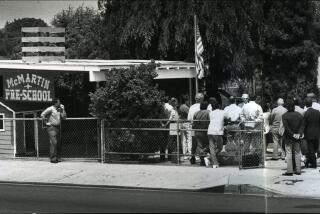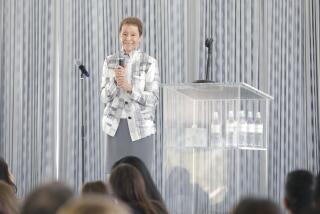Child Abuse : As Reports of Assaults Increase, So Do Efforts to Help Youngsters
SAN FRANCISCO — Missy found no joy in the sound of the final school bell. To other children it was a signal for horseplay and laughter. For Missy, it meant going home, taking off her clothes and doing as daddy said.
Susan was always fond of Mr. Jenkins. He told great stories and taught her to play cards. She used to spend Saturday mornings with him, until the day he took her upstairs and raped her.
Missy, 7, and Susan, 11, were miserable. The blaring bell made Missy cringe, and Susan was petrified when she walked past Jenkins’ home.
Missy’s mother could not help; she worked nights. And her father convinced her that if she told, her mother would abandon them and leave her alone with him forever.
Susan could not tell her parents. She felt ashamed and feared that they would not believe her.
What Susan and Missy finally learned was that they are not alone.
‘Figures Are Shocking’
About 30% of America’s children are sexually abused; one of four girls will be molested before the age of 13 and one in 11 boys by 18, according to officials of Child Assault Prevention, a Berkeley-based program that educates children, parents and teachers on child molestation. The group provided details of the tragic childhood experiences of Missy and Susan.
“The figures are shocking,” said Kate Kain, co-founder and director of training at Child Assault Prevention. “And many experts think these (figures) are on the conservative side.”
Marilyn Willard, child abuse coordinator of San Francisco’s Sex Trauma Workers, said most people do not want to admit that the crime exists.
“Yet child molesting is rising at an alarming rate both in the state and across the nation,” Willard said. “The number of (California) cases . . . is expected to at least double.”
About 80 bills dealing with the issue are expected to be introduced in the state Legislature this year. The Assembly is about to vote on a measure by Art Torres (D-Los Angeles) that would permit testimony of abused children to be presented on videotape to avoid the trauma of a court appearance.
Statistics for 1983 show that 13,214 California youngsters reported sexual abuse, and preliminary reports for 1984 indicate that the crime might double to 26,000, according to the Department of Justice’s bureau of criminal statistics.
Many Dark Secrets
Statistics, however, can be deceptive, Kain said. For every case reported, several others remain the child’s dark secret.
“It could easily be 10 times as large,” said David Finkelhor, a prominent child sexual abuse researcher. Finkelhor authored “Child Sexual Abuse” and is the associate director of the Family Violence Research Program at the University of New Hamshire.
Kain said many people think that child molestation happens somewhere else.
“They say, ‘Oh, that could only happen in a place like Los Angeles, but never here,’ ” Kain said. “The truth is, though, that the crime can happen in any city, any town, any neighborhood.”
Mary Roth, a state deputy attorney general, said, “Child molesters come from all classes, all levels of education, all races and both sexes. They are not dirty old men hanging around the playground.”
Here are some of the state’s most notorious recent cases:
- In Manhattan Beach, a 76-year-old preschool founder, three family members and three others were charged with rape, sodomy and other sexual abuse involving 42 children. Hearings for the defendants are under way. Six other preschools nearby have been ordered closed by the state because of allegations of child molestation.
- Jeffery Lee Gridley, 34, agreed last Oct. 16 to a state prison term of 71 years after pleading guilty to sexually molesting nine boys. The defendant coached Little League baseball and youth football and was a trusted baby sitter.
- Former San Diego TV anchorman Maurice Heald was sentenced in July to three years in prison for molesting a 12-year-old boy. Prosecutors said he told the boy’s mother that he was conducting medical research and she let him spend time alone with the boy.
Are Numbers Increasing?
No one is certain whether child sexual abuse is growing or whether the numbers are climbing because the problem has come out into the open.
“Maybe reports have increased because of increased public awareness,” Willard said. “But we don’t know for sure whether the reports are increasing or the actual cases are increasing.”
One fact is certain, however, said Kenneth Lanning, the FBI’s child sexual abuse and pornography specialist.
“Sexual victimization of children is the most under-reported serious crime in the country,” Lanning said. “People do not want to believe this.”
Technically, it is called pedophilia, an addiction in which children are the preferred sexual object.
One organization, the Los Angeles-based Rene Guyon Society, wants to legalize child-adult sex at any age, including intercourse and oral and anal copulation.
The organization, whose slogan is “Sex By Year 8 Or It’s Too Late,” claims 5,000 members. A spokesman for the society, who did not wish to be identified, said children “want to have sex starting at two years, or at 1 1/2.”
Teaching Self-Defense
Kain said her organization teaches youths to defend themselves against both strangers and acquaintances.
“Kids are always taught to look out for the stranger danger, but they are not told about defending themselves against people they know,” Kain said.
“The sad truth is that 80% of the time, they are molested by someone who they know and trust,” she said.
Volunteers from Child Assault Prevention tell children to beware of anyone who threatens their well-being, she said.
Using plays and skits, volunteers act out dangerous situations. Skits focus on three common types of assault. The first one focuses on the bully. The second is assault by a stranger, and the third is incest.
“We teach children the difference between a good and a bad kiss and give them a range of options to deal with the problem, which include assertiveness skills and getting held, from adults they trust,” Kain said. “We tell them that a bad kiss is the one that is asked to be kept a secret.
‘Leave Me Alone’
“They’re also taught simple self-defense techniques, such as saying ‘No, leave me alone,’ and telling the person they’re going to tell someone,” Kain said.
She said the program, patterned after the National Assault Prevention Center in Columbus, Ohio, has had tremendous success.
“What we say in the field is that we are finally breaking the silence, and, most importantly, children themselves are breaking the silence.”
More to Read
Sign up for Essential California
The most important California stories and recommendations in your inbox every morning.
You may occasionally receive promotional content from the Los Angeles Times.










